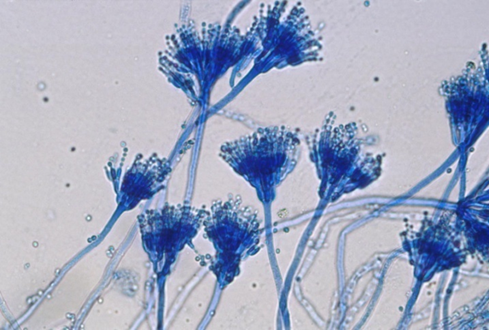LACTOPHENOL COTTON BLUE (LPCB) STAINING
AIM
To identify the Microscopic morphology
of Fungi by Lactophenol Cotton Blue (LPCB) Staining.
PRINCIPLE
Fungi are the Eukaryotic
microorganisms which are classified into two main group viz., (i) Molds
(Multicellular) and (ii) Yeasts (Unicellular). The Lactophenol Cotton Blue
(LPCB) is a stain used for making semi-permanent microscopic preparation of
Fungi. The LPCB stain has three components: (i) Phenol – Act as a Disinfectant
or Fungicide and kills any living microorganisms; (ii) Lactic acid – Preserves
the Fungal structure and (iii) Cotton blue stain - Stains the chitin and
cellulose of the fungal cell wall intensely blue. LPCB solution is
a mounting medium and staining agent used in the
preparation of slides for microscopic examination of fungi. In LPCB staining,
fungal elements are stained intensely in Blue colour.
MATERIALS REQUIRE
- Fungal culture plate
- Lactophenol Cotton Blue (LPCB) Stain
- Bunsen burner
- Teasing needle
- Glass slide
- Coverslip
- Microscope.
PROCEDURE
- Place a drop of Lactophenol Cotton Blue reagent on a clean, grease free and dry slide. The stain imparts a blue colouration on hyphae.
- By using a Teasing needle, carefully tease the small portion of fungal culture into a thin preparation and form the Fungal mycelial mat.
- Place a coverslip gently on the Fungal mycelial mat without air bubbles and wait for about 3 - 5 minutes.
- Observe under microscope at 40 X objective lens for detailed examination of Fungal morphology and Spores.
OBSERVATION AND RESULTS
The
morphology of the fungi appears (mycelium and spores) as dark blue stained
mycelium under microscope in 45 X objective.
Figure – 1: Microscopic morphology of Aspergillus
niger
Figure – 2: Microscopic morphology of Aspergillus flavus
Figure – 3: Microscopic morphology of Aspergillus fumigatus
Figure – 4: Microscopic morphology of Penicillium chrysogenum
Figure – 5: Microscopic morphology of Rhizopus sp. (Rhizoids present)
Figure – 6: Microscopic morphology of Mucor sp. (Rhizoids absent)










Comments
Post a Comment